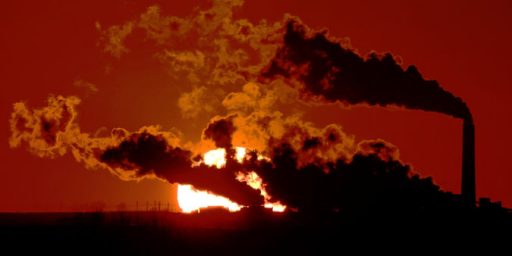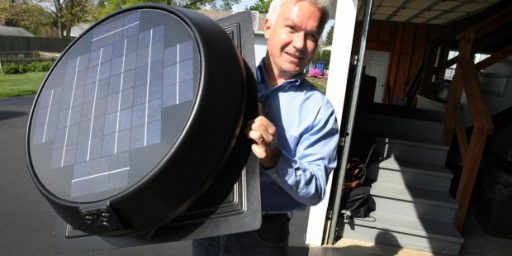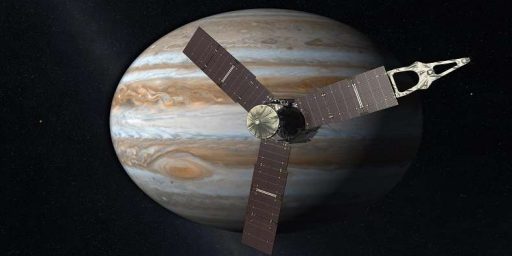BLM Freezes New Solar Development for Two Years
The Bureau of Land Management has placed a two year moratorium on new solar power projects proposed for building on public lands.
Faced with a surge in the number of proposed solar power plants, the federal government has placed a moratorium on new solar projects on public land until it studies their environmental impact, which is expected to take about two years.
The Bureau of Land Management says an extensive environmental study is needed to determine how large solar plants might affect millions of acres it oversees in six Western states — Arizona, California, Colorado, Nevada, New Mexico and Utah.
Now, this won’t affect any pending proposal–apparently there are about 130 in the works. But at least on face, this ban doesn’t appear to make a lot of sense. It seems to me that there isn’t any reason why the BLM couldn’t study the environmental impacts of solar power while still allowing new proposals–as new information is gathered, the EIR’s for new projects could just be changed accordingly. At a time when we’re giving due consideration to opening up new oil and gas projects on public lands, a freeze on solar power seems counterproductive.






Counterproductive for whom, Alex? The coal lobby? Drilling interests? Both of whom are tightly wired into the existing campaign-finance racket? I’d say this decision is very productive indeed.
Alex, It is important to understand how the BLM has been treated by environmental groups for the last 20 years. Nearly every logging sale in the west has been challenged through the courts, species protection and more importantly habitat protection suits keep them in court, even long term management plans end up in court just to delay them and extract extreme concessions for the environmentalists.
I can guarantee you there have been complaints from the environmental lobby that things are moving too fast. Knowing the track record of these groups the BLM is just heading off trouble.
Those of you on the east coast just don’t understand what these greens are all about. Out here we have learned the hard way.
How many projects can the BLM monitor at its current level of funding? Can it monitor the projects already has on its plate?
BLM is required, as are all federal agencies, to comply with the National Environmental Policy Act (NEPA). In simple terms, NEPA requires that BLM take into account the environmental impacts of BLM actions in BLM’s planning process. BLM has long-standing regulations and processes published in the CFR for complying with NEPA. If BLM does not comply with those regs, any interested party (environmental group, trade association, or “your uncle Charlie”) can object, appeal, and/or litigate and likely prevail in halting any actions that are not in compliance with BLM’s NEPA process.
NEPA compliance and NEPA inadequacy is commonly used to oppose,halt, or modfy federal actions. For example, it has been used to present opposition to the Cape Wind project off Nantucket, delay/prevent the opening of the Yucca Mountain radioactive waste facility, and limit coal bed methane development in the mountain west.
BLM has no choice, unless Congress specifically exempts solar development on federal lands from NEPA. The lottery has better odds!
As noted (or strongly implied) in comments already, this is not aimed at solar projects as such; all construction projects in BLM must undergo an EIR, and the BLM is just trying to bypass some suits by “grandfathering” in-progress work.
OTOH, it is aimed at solar, and probably will be at wind, for the sheer amount of land involved. It would be at grazing, drilling, mining, logging, etc except those are mostly works already being done. If, for example, drilling for oil is allowed again (yeah, I know, it is not banned, just under a permanent “moratorium” aka death-watch) the BLM will almost certainly have to do the same thing.
BLM completed a Programmatic EIS for wind development several years ago, so wind development is further down the road with only site/project specific NEPA compliance required.
That still presents a hurdle to be cleared, but is a somewhat smaller one depending on the size and location of a wind project.
There are a number of existing wind energy projects already in operation on BLM lands and more in various stages of development.
Wow! I am really glad to see that our national efforts to provide energy, in all its various forms, and to keep our society and economy alive and healthy are beginning to work so well. Now even the harmless, in the future, answers aren’t OK.
Let’s see…We decided to become dependent on cheap foreign sources of energy so we can keep our own backyard pretty all the while knowing that the clock was rapidly ticking towards midnight. Meanwhile, those supplying the energy helped us become addicted and now have decided to use it as a weapon, both economic and political, while we “taking the moral high ground’ have decided we can not use our only comparable weapon, food, to even the playing field.
In the meantime, we have decided we won’t drill on land: won’t drill offshore; won’t crush shale; couldn’t refine it if we did. We have developed no significant source of bio-fuel. The only semi-significant source of bio-renewable fuel requires using a major food source at the expense of feeding people at reasonable prices; Additionally, we: don’t gasify coal; won’t put up more wind generators; won’t add more solar; won’t use the shorelines to harness tidal surges to generate power, and haven’t developed geo-thermal. Can’t change generation systems fast enough to conserve enough. Don’t want to use nuclear power generation and we won’t transport the waste to safely store it if we did. Can’t change transportation systems fast enough to conserve enough. Haven’t developed hydrogen fuel systems enough to be useful. Don’t have a supply infrastructure to support it if we did. Don’t have a viable battery technology that is a sufficiently manufacturable yet. Plus, all the current battery technologies present major heavy metal problems when we do. Additionally, we’ve encouraged a relatively small hand full of speculators to get rich while we are forced to pay for their pleasure and prosperity. Allowed the enviro-extremists’, who don’t have any answers to our needs, to have veto power so we can’t do anything they don’t like anyway. And the ‘Not in my backyard’ crowd has been given the power to say no to whatever they don’t like also.
And to top it all off, as the comments about this post will undoubtedly show, we will continue to quibble about the trivial, make the inane the center point, and when all is said and done — do nothing! Then when it is too late we will look to blame our Nero and wonder how he could have fiddled our prosperity and lives, as we have known them, away. Look around folks, we are Nero and none of want to be responsible but in reality we all are!
Having done EIS/EIR process before for Federal Agencies, 2 years is a pretty quick turn around for a EIS/EIR of that size and scope.